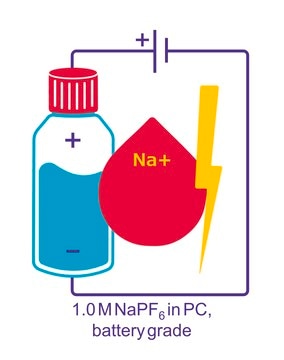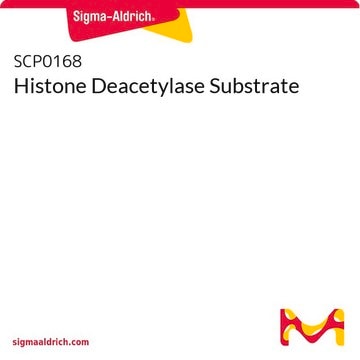Recommended Products
usage
100 assays in 96 well plates
NCBI accession no.
shipped in
wet ice
storage temp.
−20°C
Gene Information
human ... HDAC3(8841)
mouse ... HDAC3(15183)
General description
Histone deacetylases (HDACs) are a large family of enzymes that remove acetyl groups from histone proteins. Site specific histone acetylation and deacetylation have been shown to activate or repress eukaryotic gene transcription, respectively, and as a consequence, it plays a crucial role in mammalian development and disease. HDACs are involved in important biological activities, such as cell differentiation, proliferation, apoptosis, and senescence.
With Sigma′s HDAC3 Activity Assay Kit, HDAC3 present in a test sample will act with the supplied Developer, to deacetylate and then cleave the HDAC3 Substrate [R-H-K-K(Ac)-AFC]. This activity will release the quenched fluorescent group, AFC, which can be detected at Em/Ex = 380/500 nm. Trichostatin A is an HDAC inhibitor included in the kit to verify HDAC3 activity. The kit provides a rapid, simple, sensitive and reliable test. It is suitable for either individual tests or high throughput assays, from nuclear extracts, purified, or immunoprecipitated HDAC3, and from native, recombinant, or genetically modified HDAC3.
With Sigma′s HDAC3 Activity Assay Kit, HDAC3 present in a test sample will act with the supplied Developer, to deacetylate and then cleave the HDAC3 Substrate [R-H-K-K(Ac)-AFC]. This activity will release the quenched fluorescent group, AFC, which can be detected at Em/Ex = 380/500 nm. Trichostatin A is an HDAC inhibitor included in the kit to verify HDAC3 activity. The kit provides a rapid, simple, sensitive and reliable test. It is suitable for either individual tests or high throughput assays, from nuclear extracts, purified, or immunoprecipitated HDAC3, and from native, recombinant, or genetically modified HDAC3.
Features and Benefits
- Simple, sensitive, and reliable assay
- Simple procedure; takes ~60 min
- Utilizes fluorometric methods
- Sample type: cell and tissue lysates, plasma and serum, other biological fluids
- Species reactivity: mammalian
- Suitable for individual tests or high throughput assays and kinetic studies
- Convenient 96-well microplate format
- Suitable for high throughput measurement of HDAC3 activity in purified, immunoprecipitated and recombinant or genetically modified HDAC3 samples
related product
Product No.
Description
Pricing
Storage Class Code
10 - Combustible liquids
WGK
WGK 3
Flash Point(F)
188.6 °F - closed cup
Flash Point(C)
87 °C - closed cup
Certificates of Analysis (COA)
Search for Certificates of Analysis (COA) by entering the products Lot/Batch Number. Lot and Batch Numbers can be found on a product’s label following the words ‘Lot’ or ‘Batch’.
Already Own This Product?
Find documentation for the products that you have recently purchased in the Document Library.
Karolina J Janczura et al.
Proceedings of the National Academy of Sciences of the United States of America, 115(47), E11148-E11157 (2018-11-07)
Alzheimer's disease (AD) is the leading cause of age-related dementia. Neuropathological hallmarks of AD include brain deposition of β-amyloid (Aβ) plaques and accumulation of both hyperphosphorylated and acetylated tau. RGFP-966, a brain-penetrant and selective HDAC3 inhibitor, or HDAC3 silencing, increases
Yong Wang et al.
Circulation research, 114(6), 957-965 (2014-01-31)
Our previous study has shown that yes-associated protein (YAP) plays a crucial role in the phenotypic modulation of vascular smooth muscle cells (SMCs) in response to arterial injury. However, the role of YAP in vascular SMC development is unknown. The
Bihua Bie et al.
Nature neuroscience, 17(2), 223-231 (2014-01-21)
Amyloid-induced microglial activation and neuroinflammation impair central synapses and memory function, although the mechanism remains unclear. Neuroligin 1 (NLGN1), a postsynaptic protein found in central excitatory synapses, governs excitatory synaptic efficacy and plasticity in the brain. Here we found, in
Ji Heon Noh et al.
Cancer research, 74(6), 1728-1738 (2014-01-23)
Aberrant regulation of histone deacetylase 2 (HDAC2) contributes to malignant progression in various cancers, but the underlying mechanism leading to the activation of oncogenic HDAC2 remains unknown. In this study, we show that HDAC2 expression is upregulated in a large
Shuai Huang et al.
Cell communication and signaling : CCS, 19(1), 35-35 (2021-03-20)
The mechanism underlying endothelial dysfunction leading to cardiovascular disease in type 2 diabetes mellitus (T2DM) remains unclear. Here, we show that inhibition of histone deacetylase 3 (HDAC3) reduced inflammation and oxidative stress by regulating nuclear factor-E2-related factor 2 (Nrf2), which
Our team of scientists has experience in all areas of research including Life Science, Material Science, Chemical Synthesis, Chromatography, Analytical and many others.
Contact Technical Service








